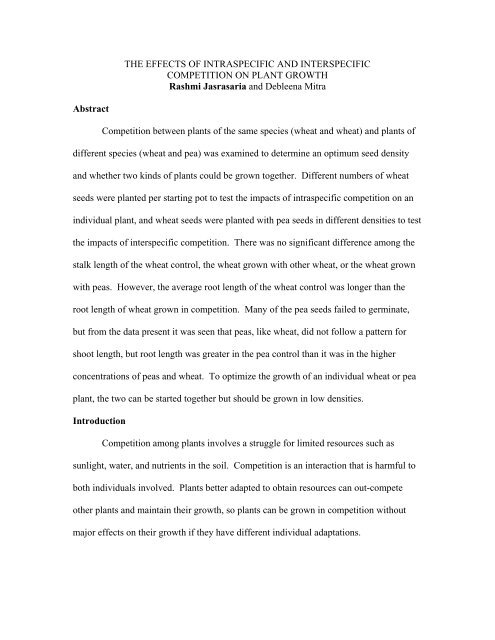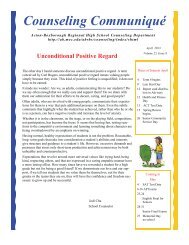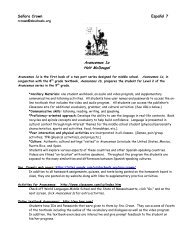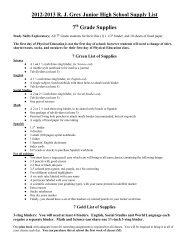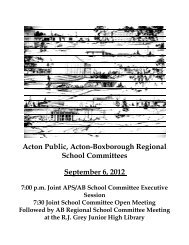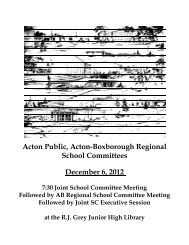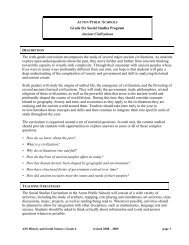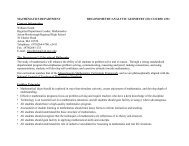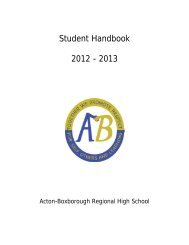THE EFFECTS OF INTRASPECIFIC AND INTERSPECIFIC
THE EFFECTS OF INTRASPECIFIC AND INTERSPECIFIC
THE EFFECTS OF INTRASPECIFIC AND INTERSPECIFIC
Create successful ePaper yourself
Turn your PDF publications into a flip-book with our unique Google optimized e-Paper software.
Abstract<br />
<strong>THE</strong> <strong>EFFECTS</strong> <strong>OF</strong> <strong>INTRASPECIFIC</strong> <strong>AND</strong> <strong>INTERSPECIFIC</strong><br />
COMPETITION ON PLANT GROWTH<br />
Rashmi Jasrasaria and Debleena Mitra<br />
Competition between plants of the same species (wheat and wheat) and plants of<br />
different species (wheat and pea) was examined to determine an optimum seed density<br />
and whether two kinds of plants could be grown together. Different numbers of wheat<br />
seeds were planted per starting pot to test the impacts of intraspecific competition on an<br />
individual plant, and wheat seeds were planted with pea seeds in different densities to test<br />
the impacts of interspecific competition. There was no significant difference among the<br />
stalk length of the wheat control, the wheat grown with other wheat, or the wheat grown<br />
with peas. However, the average root length of the wheat control was longer than the<br />
root length of wheat grown in competition. Many of the pea seeds failed to germinate,<br />
but from the data present it was seen that peas, like wheat, did not follow a pattern for<br />
shoot length, but root length was greater in the pea control than it was in the higher<br />
concentrations of peas and wheat. To optimize the growth of an individual wheat or pea<br />
plant, the two can be started together but should be grown in low densities.<br />
Introduction<br />
Competition among plants involves a struggle for limited resources such as<br />
sunlight, water, and nutrients in the soil. Competition is an interaction that is harmful to<br />
both individuals involved. Plants better adapted to obtain resources can out-compete<br />
other plants and maintain their growth, so plants can be grown in competition without<br />
major effects on their growth if they have different individual adaptations.
Intraspecific and interspecific competition between two species of plants were<br />
examined in this study to help a group of organic farmers determine the best planting<br />
arrangement, including the optimum density of seeds and the optimum combination of<br />
plants of different species. The farmers would like to maximize their crop of healthy<br />
seedlings in a limited amount of space. The purpose of this study was to find the balance<br />
between competition and healthy growth.<br />
Competition is a very important part of plant interactions. Plants undergo two<br />
types of competition: intraspecific, among their own species, and interspecific, with<br />
plants of another species. The two kinds of competition have distinct effects.<br />
Intraspecific competition is the most aggressive because plants of the same species have<br />
the same needs and same resource-obtaining structures (Alexander et al., 1970). There<br />
are three principle effects of intraspecific competition outlined in a series of papers by<br />
Yoda et al., 1963: the average size of a plant decreases as density increases, the size<br />
structure of the population becomes hierarchical and self-thinning or density dependent<br />
mortality occurs (Park et al., 2003). For interspecific competition, many different<br />
experimental designs have been employed, for researchers have different aims (Park et al.,<br />
2003). The replacement series is one design where the proportions of one plant to<br />
another are changed, but the total density is kept constant. According to Park et al., 2003,<br />
many argue this does not separate the effects of intra and interspecific competition, so is<br />
not an adequate design. Another design is the additive design where both density and<br />
proportion are altered, and this yields a simple hyperbolic relationship between the crop<br />
damage and number of weeds (Park et al., 2003).<br />
2
However, in this study, the goal was not to study crop-weed interspecific<br />
competition, but intercropping, and whether two crops could be planted together to<br />
produce higher, healthier yields in smaller space. In his 2003 Agronomy Guide, Preston<br />
Sullivan said, “Intercrops can be more productive than growing pure stands.” He argues<br />
there is more stability in diversity established in having more than one crop. The reason<br />
to intercrop is to increase the productivity of the land, and when the density, maturity<br />
dates, and plant architectures are taken into account, it can be very successful (Sullivan,<br />
2003). In 2003, Sullivan described a South Carolina trial where corn and peas were<br />
intercropped at three different corn densities. There was a definite yield advantage from<br />
intercropping than from growing the two crops pure stand, but the peas suffered from<br />
increased competition in the higher densities of corn (Sullivan, 2003). A balance must be<br />
attained.<br />
The specific purpose of this study was to find an optimum density for growing<br />
wheat and to find out whether wheat and peas could be grown together to maximize yield<br />
per area. It was hypothesized that there would be no difference in the stalk length (above<br />
ground height of the plants) or the root length between pure wheat grown at a density of<br />
two per pot and wheat grown at higher densities, and that there would be no difference<br />
between the control wheat and the wheat grown with pea seeds. The purpose of the<br />
experiment was to find out whether competition (intraspecific or interspecific) did indeed<br />
effect the growth of individual plants.<br />
Materials and Methods<br />
The experiment began on September 28, 2004. After planning out the<br />
experimental design, 42 small starting pots were obtained and filled three-fourths of the<br />
3
way with potting soil. Then seeds were placed inside each pot according to the<br />
arrangement shown in Figure 1. 94 wheat seeds from a brown paper bag were used and<br />
44 Alaskan pea seeds from a plastic bag full of seeds were used. The seeds were spaced<br />
evenly within the pots. Then the pots were filled to the top with soil and watered. The<br />
36 connected pots were covered with plastic and placed under one plant light inside a<br />
classroom close to the windows, and the other 6 were placed under the adjacent plant<br />
light and were covered, but air could still pass under the cover, for it was not a perfect fit<br />
over the smaller number of pots. Every school day, around 12:40 PM, the plants were<br />
watered, and extra water was given before a weekend, so the plants would not dry out.<br />
Figure 1<br />
2 W 2 W 2 W<br />
2 W 2 W 2 W<br />
2 W 2 W 2 W<br />
2 P 2 P 2 P<br />
2 P 2 P 2 P<br />
2 P 2 P 2 P<br />
2 W 2 W 2 W<br />
2 W 4 W 4 W<br />
4 W 6 W 6 W<br />
8 W 10 W 1P, 1W<br />
1P, 1W 1P, 1W 1P, 1W<br />
1P, 1W 2P, 2W 2P, 2W<br />
Once the plants were too tall and the wheat stalks were<br />
2P, 2W 3P, 3W<br />
3P, 3W 4P, 4W<br />
5P, 5W EXTRA<br />
hitting the cover, the covers were<br />
removed. This was after about 11 days.<br />
They continued to be watered. On<br />
The arrangement of seeds planted.<br />
W= wheat seed, P= pea seed, each cell=<br />
one starting pot. 36 were all together in<br />
one tray, and the other 5 were in the<br />
neighboring tray. The top 9 are wheat<br />
controls. The next 9 are pea controls.<br />
The next 11 cells show wheat<br />
intraspecific competition at different<br />
densities, and the last 12 cells show pea<br />
and wheat interspecific competition.<br />
October 13,<br />
the wheat<br />
controls and<br />
pea controls<br />
were uprooted<br />
and measured.<br />
The individual plants were carefully pulled out of the pots,<br />
and the soil was washed off in a beaker of water. Then,<br />
using a metric ruler, the stalk length and root length of each plant was measured and<br />
recorded. The number of leaves and the number of tendrils (on the peas) were also noted.<br />
4
The rest of the plants were uprooted and measured on October 14, 2004. After all the<br />
data was collected, the plants were thrown away, and the pots were cleaned out. The data<br />
was entered into Microsoft Excel and analyzed using statistics to make bar graphs. The<br />
experiment had been completed.<br />
Results<br />
Of the 138 seeds planted, only 97 germinated and grew. Of those 97, only 15<br />
were pea plants. There is clearly a lack of pea data in the interspecific competition<br />
results; however, some trends are still visible. In the intraspecific competition<br />
comparison, the average root length of the wheat control was greater than the mean root<br />
lengths of wheat grown at increased densities. Of the 12 individual wheat seedlings,<br />
grown four per pot, six had root lengths beneath the 95% confidence interval of the wheat<br />
control (10.985-25.605 cm), and this trend continued, for six of the ten wheat seeds,<br />
grown five per pot, had root lengths outside of the wheat control confidence interval.<br />
Wheat grown six and eight per pot did better with higher average root lengths than wheat<br />
grown four and five per pot.<br />
root length in cm<br />
30<br />
25<br />
20<br />
15<br />
10<br />
5<br />
0<br />
Wheat Intraspecific Competition: Root Length Means<br />
and 95% Confidence Intervals<br />
control (2) 4 6 (act 5)<br />
1 8 (act 6) 10 (act 8)<br />
number of seeds per pot<br />
act = # that actually<br />
germinated<br />
5
There is no such distinction between the stalk/shoot length of the wheat control and<br />
wheat grown at higher densities. The graph of the means is flat, and the confidence<br />
intervals are large. Shoot lengths were constant throughout the study of intraspecific<br />
competition.<br />
shoot length in cm<br />
30<br />
25<br />
20<br />
15<br />
10<br />
5<br />
Wheat Intraspecific Competition: Shoot Length<br />
Means and 95% Confidence Intervals<br />
0<br />
control (2) 4 6 (act 1 5) 8 (act 6) 10 (act 8)<br />
act = # that actually<br />
germinated<br />
number of seeds per pot<br />
This trend of constant shoot length persisted in the interspecific study as well.<br />
Wheat stalk lengths did not vary very much when wheat was planted with peas. It can be<br />
seen that the means are very close in the summary table of statistics (Figure 2).<br />
Interspecific Competition: Wheat Stalk Lengths (cm)<br />
control (2 wheat) 1 wheat, 1 pea 3 wheat, 2 peas 5 wheat, 2 peas<br />
mean 17.11905 17.55 18.8 17.3<br />
std dev 2.11533 0.353553 3.325658 0.223607<br />
66% interval 15.00372 17.19645 15.47434 17.07639<br />
19.23438 17.90355 22.12566 17.52361<br />
95% interval 21.34971 16.84289 12.14868 16.85279<br />
12.88839 18.25711 25.45132 17.74721<br />
Figure 2<br />
Wheat root length, though, did decrease as pea density increased, but it was<br />
constant between the wheat control and the one wheat grown with one pea. There were<br />
6
two of the six wheat grown as 3 wheat seeds with 2 pea seeds per pot that were beneath<br />
the wheat control’s confidence interval. One of these plants had a root length of only 4.5<br />
cm. In the 5 wheat with 2 peas pot, four of the five wheat seedlings had roots too short to<br />
be within the confidence interval of the control, and one plant had a root length of only<br />
5.5 cm.<br />
rootl length in cm<br />
30<br />
25<br />
20<br />
15<br />
10<br />
5<br />
0<br />
Wheat Interspecific Competition: Root Length Means<br />
and 95% Confidence Intervals<br />
control<br />
(2 wheat)<br />
1 wheat, 3 wheat,<br />
1 pea<br />
1<br />
2 peas<br />
number of seeds per pot<br />
5 wheat,<br />
2 peas<br />
From the available minimal pea plant data, the same results predominated. Root length<br />
decreased as wheat density increased. However, it actually increased with the addition of<br />
one wheat plant. The pea control mean root length was 10.5 cm, and it had a 95%<br />
confidence interval from about 6 to 15 cm. The 1 pea, 1 wheat peas (of which there were<br />
only two) had about 14 cm long roots, but this upward trend could have been exaggerated.<br />
root length in cm<br />
20<br />
15<br />
10<br />
5<br />
0<br />
Pea Interspecific Competition: Root Length Means<br />
and 95% Confidence Intervals<br />
control (1) 1 pea,<br />
1 wheat<br />
2 peas, 3<br />
1<br />
wheats<br />
number of seeds per pot<br />
7<br />
2 pea,<br />
5 wheats
Pea shoot length was varied, and the control had a huge confidence interval of about 5.8<br />
to 41.6 cm because one of the six control peas had a stalk length of 5.5 cm. This may<br />
have thrown off some of the statistics along with the low number of data points, for if this<br />
low value was not included in the calculation of the mean, the mean would be 27.3 cm<br />
instead of 23.6 cm.<br />
In general, root length is greater when the plants are growing in low densities<br />
even if the plant species are mixed, and shoot/stalk length is not affected very much by<br />
competition. The number of leaves on the wheat plants was always two, except for a few<br />
individual plants in intraspecific competition that had only one leaf. For the peas,<br />
number of leaves varied directly with the height of the stalk. Taller plants had more<br />
leaves, and tendrils followed this model as well. In one instance of interspecific<br />
competition between three wheat and two peas, one of the pea tendrils was knotted<br />
around the tip of a wheat leaf, but it did not seem to be harming the wheat plant in any<br />
way. Although many peas did not germinate, general trends were visible in the<br />
experiment results.<br />
Discussion<br />
Through looking at the data, certain conclusions are reached. The previous null<br />
hypothesis that there is no significant difference between the average individual wheat<br />
plant grown alone, grown in greater density and grown with a different species plant must<br />
be rejected. There are several differences between the wheat control and wheat grown<br />
with other wheat at high densities. First, the root lengths of the wheat control are higher<br />
than the wheat grown at a greater density. Shoot length may be very similar, but the<br />
roots are the major resource obtaining structures in plants. Most of the competition must<br />
8
e for the water and nutrients in the soil because the leaves are responsible for taking in<br />
sunlight, and most of the wheat seedlings had two leaves that were about the same size.<br />
Wheat grown with peas also yielded the same difference. Roots were longer in wheat<br />
grown at lower densities of two plants per pot, be they two wheat plants or one wheat<br />
plant and one pea plant. As soon as the number of plants per pot was increased to 5 or 7,<br />
the root length decreased. Clearly, wheat grows better in lower densities, but it can easily<br />
be grown with another species. For farmers looking to grow wheat, an optimum density<br />
is two wheat seedlings per starting pot, and wheat can be grown with peas, for the root<br />
length stayed constant.<br />
The null hypothesis that there is no significant difference between the root length<br />
and stalk length of peas grown alone in low density and peas grown with wheat cannot<br />
fully be rejected or accepted because there is not adequate data to analyze. There are<br />
only six data points for the control, two for the one pea/one wheat, none for two pea/two<br />
wheat (only the wheat grew), four for three pea/three wheat (which turned out to be two<br />
pea/three wheat), one for four pea/four wheat (which turned out to be one pea, three<br />
wheat, so it was not included in the analysis), and two for the five pea/five wheat (which<br />
turned out to be two pea/five wheat). With data sets of only two points, the conclusions<br />
reached are probably exaggerated or non-existent. There was a difference in the root<br />
length of the pea controls and interspecific competing peas. Root length decreased with<br />
increased density, but actually increased when one pea plant was grown with one wheat<br />
plant. It actually may be beneficial to farmers to grow wheat and Alaskan peas together,<br />
for the wheat’s root length was not affected, and the pea’s root length increased.<br />
Growing two plants in one area will maximize yield and the two plants that have slightly<br />
9
different niches could cooperate. The stalk length was too variable to place a trend upon,<br />
so for that the null hypothesis can be accepted, meaning there is no significant difference<br />
in pea stalk height based on competition. Eventually, though, plants with longer roots<br />
will do better competitively than plants with shorter roots, for they can reach more<br />
nutrients and have more surface area to absorb water, so if the experiment was continued<br />
past 17 days, these plants with longer roots could have grown longer stalks as well.<br />
The conclusions reached in this lab verify the statement put forth in 1970 by<br />
Alexander et al. that intraspecific competition is more damaging, for plants of the same<br />
species have the exact same needs and adaptations. The wheat root lengths were hurt<br />
more by increased density among other wheat plants than among the same number of<br />
peas. For example, the mean root length of 5 wheat seeds per pot was 9.86 cm, which<br />
was less than the mean root length of 3 wheat and 2 pea seeds per pot (10.55 cm). It is<br />
the same density, but that addition of peas instead of wheat yields longer roots. The<br />
increase in root length in one pea grown with one wheat seed versus one pea grown alone<br />
supports Sullivan’s statement that intercropping can be beneficial. However, this<br />
increase could be inflated because there was not enough pea data.<br />
When retrying such an experiment, there are several design changes that should<br />
be made. First, fresh seeds that have a higher probability of germination should be used.<br />
In this study, two year old Alaskan pea seeds that had been stored in a plastic bag had<br />
been used, and not very many actually germinated. Also, learning how to lightly add pot<br />
soil on top may help, for it may have been too packed for some seeds to grow in this<br />
experiment. In addition, it would be more controlled to have all the pots on one tray<br />
under the same light, so the resources being received are the same. To create more<br />
10
drastic results, the density of the wheat in intraspecific competition could be increased to<br />
20 seeds per pot at most and 1 seed per pot at least, and then it could increase by fives in<br />
between. This would give a wider range of data, and if most seeds germinated, there<br />
would be more data points as well. These were some improvements that could be made<br />
to the experimental design.<br />
To test other aspects of interspecific competition, it would be interesting to vary<br />
the proportions of one species to another in the same area to see if one species dominates<br />
the other or find an optimum proportional relationship, suppose five wheat seedlings and<br />
only one pea because the pea is heavier and larger. Another experiment that would<br />
clarify some doubt about the benefits of interspecific competition would be to set up a<br />
control of wheat, interspecific competition with one species, and competition with<br />
another species to see if it depends what species the wheat is most cooperative or<br />
competitive with.<br />
The relevance of this experiment is slightly questionable, for a starting pot is a<br />
very rough simulation of two crops being planted in rows in a field. It may be more<br />
relative to study weed-flower competition, for this applies more to students who have<br />
experienced domestic gardening and attracts more interest. A longer experiment that<br />
lasted through plant maturity would also be more relevant, for plants in this study that<br />
were benefiting at the stage where they were uprooted, may have been struggling as other<br />
plants around them matured. It would also be helpful to learn some background about<br />
each of the plant species that are used in this study, for then specific needs and<br />
adaptations would be known and the interspecific study would be more relevant.<br />
11
The experiment was still helpful in portraying the differences between intra and<br />
interspecific competition and portraying a practical application of descriptive statistics in<br />
the real world. It was also interesting to develop an original experimental design to<br />
figure out a real situation. Wheat and peas can be grown together just in low densities (2<br />
seeds per starting pot).<br />
Literature Cited<br />
Alexander, Taylor R., R. Will Burnett, and Herbert S. Zim 1970. Botany. New York:<br />
Golden Press, Western Publishing Company.<br />
Park, Sarah E., Laurence R. Benjamin, and Andrew R. Watkinson 2003. The Theory and<br />
Application of Plant Competition Models: an Agronomic Perspective. Annals of<br />
Botany. Oxford Journals Online.<br />
http://aob.oupjournals.org/cgi/content/full/92/6/741.<br />
Sullivan, Preston 2003. Intercropping Principles and Production Practices.<br />
http://www.attra.org/attra-pub/intercrop.html#Concepts.<br />
12


